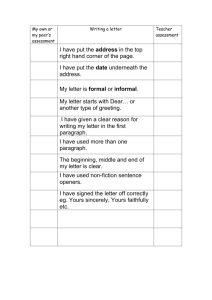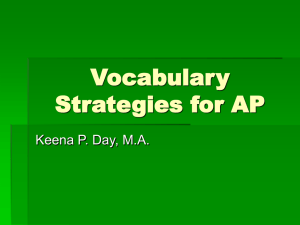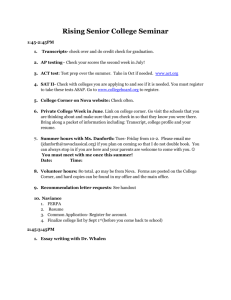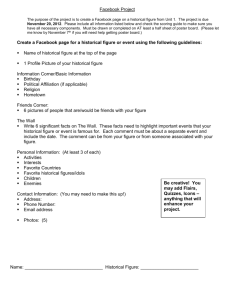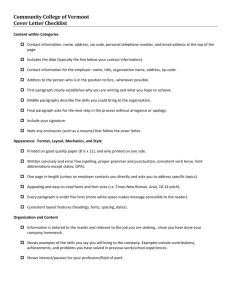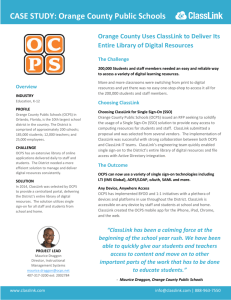Formative Assessment Strategies
advertisement
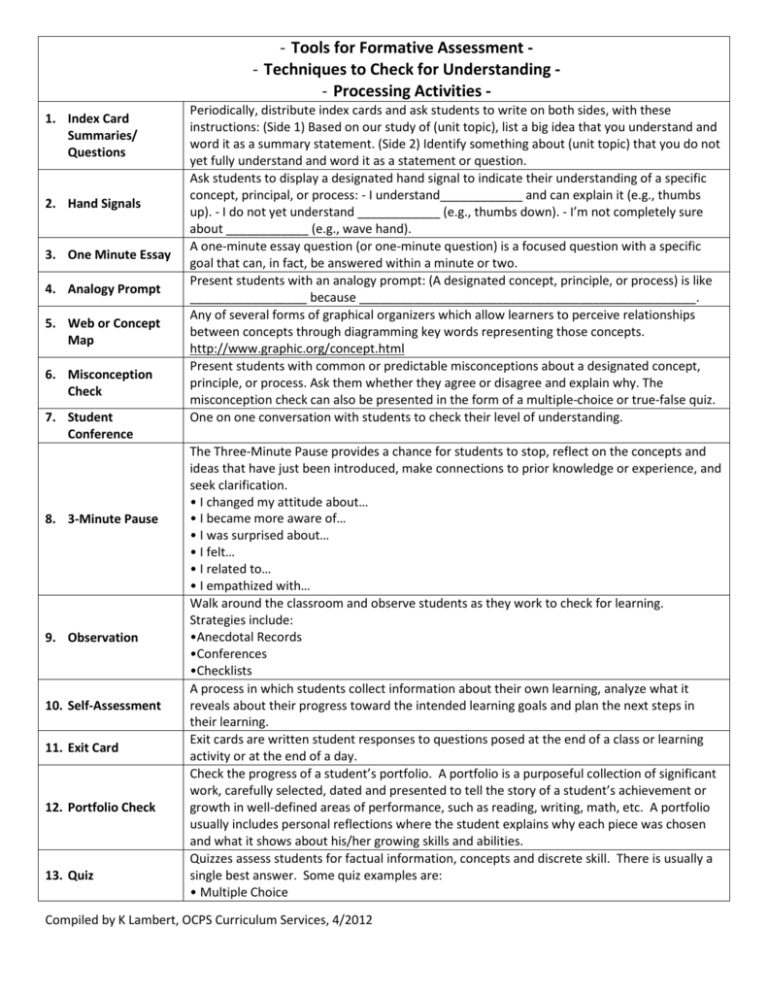
- Tools for Formative Assessment - Techniques to Check for Understanding - Processing Activities 1. Index Card
Summaries/
Questions
2. Hand Signals
3. One Minute Essay
4. Analogy Prompt
5. Web or Concept
Map
6. Misconception
Check
7. Student
Conference
Periodically, distribute index cards and ask students to write on both sides, with these
instructions: (Side 1) Based on our study of (unit topic), list a big idea that you understand and
word it as a summary statement. (Side 2) Identify something about (unit topic) that you do not
yet fully understand and word it as a statement or question.
Ask students to display a designated hand signal to indicate their understanding of a specific
concept, principal, or process: - I understand____________ and can explain it (e.g., thumbs
up). - I do not yet understand ____________ (e.g., thumbs down). - I’m not completely sure
about ____________ (e.g., wave hand).
A one-minute essay question (or one-minute question) is a focused question with a specific
goal that can, in fact, be answered within a minute or two.
Present students with an analogy prompt: (A designated concept, principle, or process) is like
_________________ because _________________________________________________.
Any of several forms of graphical organizers which allow learners to perceive relationships
between concepts through diagramming key words representing those concepts.
http://www.graphic.org/concept.html
Present students with common or predictable misconceptions about a designated concept,
principle, or process. Ask them whether they agree or disagree and explain why. The
misconception check can also be presented in the form of a multiple-choice or true-false quiz.
One on one conversation with students to check their level of understanding.
The Three-Minute Pause provides a chance for students to stop, reflect on the concepts and
ideas that have just been introduced, make connections to prior knowledge or experience, and
seek clarification.
8. 3-Minute Pause
Walk around the classroom and observe students as they work to check for learning.
Strategies include:
9. Observation
10. Self-Assessment
11. Exit Card
12. Portfolio Check
13. Quiz
A process in which students collect information about their own learning, analyze what it
reveals about their progress toward the intended learning goals and plan the next steps in
their learning.
Exit cards are written student responses to questions posed at the end of a class or learning
activity or at the end of a day.
Check the progress of a student’s portfolio. A portfolio is a purposeful collection of significant
work, carefully selected, dated and presented to tell the story of a student’s achievement or
growth in well-defined areas of performance, such as reading, writing, math, etc. A portfolio
usually includes personal reflections where the student explains why each piece was chosen
and what it shows about his/her growing skills and abilities.
Quizzes assess students for factual information, concepts and discrete skill. There is usually a
single best answer. Some quiz examples are:
Compiled by K Lambert, OCPS Curriculum Services, 4/2012
14. Journal Entry
15. Choral Response
16. A-B-C Summaries
17. Debriefing
Students record in a journal their understanding of the topic, concept or lesson taught. The
teacher reviews the entry to see if the student has gained an understanding of the topic,
lesson or concept that was taught.
In response t o a cue, all students respond verbally at the same time. The response can be
either to answer a question or to repeat something the teacher has said.
Each student in the class is assigned a different letter of the alphabet and they must select a
word starting with that letter that is related to the topic being studied.
A form of reflection immediately following an activity.
The teacher creates a spinner marked into 4 quadrants and labeled “Predict, Explain,
Summarize, Evaluate.” After new material is presented, the teacher spins the spinner and asks
18. Idea Spinner
19. Inside-Outside
Circle
20. Reader’s Theater
21. One Sentence
Summary
spinner lands in the “Summarize” quadrant, the teacher might say, “List the key concepts just
presented.”
Inside and outside circles of students face each other. Within each pair of facing students,
students quiz each other with questions they have written. Outside circle moves to create new
p
Students are asked to write a summary sentence that answers the “who, what where, when,
why, how” questions about the topic.
Description: A ___________ is a kind of____________ that ...
Compare/Contrast:
22. Summary Frames
23. One Word
Summary
24. Think-Pair- Share/
Turn to Your
Partner
25. Think-Write-PairShare
26. Talk a Mile a
Minute
27. Oral Questioning
Problem/Solution:
Cause/Effect
Select (or invent) one word which best summarizes a topic.
Teacher gives direction to students. Students formulate individual response, and then turn to
a partner to share their answers. Teacher calls on several random pairs to share their answers
with the class.
Students think individually, write their thinking, pair and discuss with partner, then share with
the class.
Partner up – giver and receiver Kind of like “Password” or “Pyramid.” Both know the
category, but the receiver has his back to the board/screen. A set of terms will appear based
on the category – giver gives clues, while receiver tries to guess the terms.
stands up
- How is __________ similar to/different from ________________?
- What are the characteristics/parts of _______________________?
- In what other ways might we show show/illustrate ___________?
- What is the big idea, key concept, moral in _________________?
- How does ________________ relate to ____________________?
- What ideas/details can you add to _________________________?
- Give an example of ____________________________________?
- What is wrong with ____________________________________?
- What might you infer from ______________________________?
- What conclusions might be drawn from ____________________?
- What question are we trying to answer? What problem are we trying to solve?
Compiled by K Lambert, OCPS Curriculum Services, 4/2012
28. Tic-Tac-Toe/
Think-Tac-Toe
29. Four Corners
30. Muddiest (or
Clearest) Point
31. 3-2-1
32. Cubing
- What are you assuming about ____________________________?
- What might happen if __________________________________?
- What criteria would you use to judge/evaluate _______________?
- What evidence supports ________________________________?
- How might we prove/confirm ____________________________?
- How might this be viewed from the perspective of ___________?
- What alternatives should be considered ____________________?
- What approach/strategy could you use to ___________________?
A collection of activities from which students can choose to do to demonstrate their
understanding. It is presented in the form of a nine square grid similar to a tic-tac-toe board
and students may be expected to complete from one to “three in a row”. The activities vary in
content, process, and product and can be tailored to address DOK levels.
Students choose a corner based on their level of expertise of a given subject.
Based on your knowledge of __________________ , which corner would you choose?
Corner 1: The Dirt
–(There’s so much dust, I can’t see where I’m going! Help!!)
Corner 2: The Paved
(It’s fairly smooth, but there are many potholes along the
way.)
Corner 3: The Highway ( I feel fairly confident but have an occasional need to slowdown.)
Corner 4: The Interstate (I ’m traveling along and could easily give directions to someone else.)
Once students are in their chosen corners, allow students to discuss their progress with others.
Questions may be prompted by teacher.
Corner One will pair with Corner Three; Corner Two will pair with Corner
for peer
tutoring.
This is a variation on the one-minute paper, though you may wish to give students a slightly
longer time period to answer the question. Here you ask (at the end of a class period, or at a
natural break in the presentation), "What was the "muddiest point" in today's lecture?" or,
perhaps, you might be more specific, asking, for example: "What (if anything) do you find
unclear about the concept of 'personal identity' ('inertia', 'natural selection', etc.)?".
3 things you found out
2 interesting things
1 question you still have
3 differences between ___
2 effects of __ on ____
1 question you still have about the topic
3 important facts
2 interesting ideas
1 insight about yourself as a learner
3 key words
2 new ideas
1 thought to think about
Write 3 questions about the text (unfamiliar words, confusing passages or ideas)
Write 2 predictions based on the text (what will happen next based on the reading)
Make one connection based on the text (connect to something you know or have
experienced)
Display 6 questions from the lesson Have students in groups of 4.
Each group has 1 die. Each student rolls the die and answers the question with the
corresponding number. If a number is rolled more than once the student may elaborate on
Compiled by K Lambert, OCPS Curriculum Services, 4/2012
33. Quick Write
The strategy asks learners to respond in 2–10 minutes to an open-ended question or prompt
posed by the teacher before, during, or after reading.
34. Directed
Paraphrasing
Students summarize in well-chosen (own) words a key idea presented during the class period
or the one just past.
35. RSQC2
In two minutes, students recall and list in rank order the most important ideas from a previous
day's class; in two more minutes, they summarize those points in a single sentence, then write
one major question they want answered, then identify a thread or theme to connect this
material to the course's major goal.
Problem/Solution Paragraph
______________present(s) a dilemma that is___________. The problem is
_______________. This has/have occurred because
_____________________________. A resolution is/was possible. To solve it/this, it
will be/has been necessary to _______________
____________________________________________. The solution(s) include(s)
_____________________________________________________________________________.
Compare and Contrast Paragraph
There are several differences between ______________ and
. In contrast to
. Unlike _____,
_____. They
,
has
does not
_________ __. On the other hand,
Description Paragraph
36. Writing Frames
Have you ever _________________?
It/they has/have
has/have
. It/they also
.
has/have very interesting characteristics.
.
it/they
which enhances
Cause and Effect Paragraph
_________________ is influenced by
___ . Since
happened, then ___________________.
Therefore,______________________________. This provides explanation for ______
___and ____ ___________
impact is
.
. The
Sequence Paragraph
The events/process of __________ is __________________. The first ____
___
. Then,
. Next,
______
________________________.
,__________________________.
Compiled by K Lambert, OCPS Curriculum Services, 4/2012
37. Decisions,
Decisions
(Philosophical
Chairs)
38. Somebody
Wanted But So
39. Likert Scale
40. I Have the
Question, Who
Has the Answer?
41. Whip Around
42. Word Sort
43. Triangular Prism
(Red,
Yellow, Green)
Given a prompt, class goes to the side that corresponds to their opinion on the topic, side
share out reasoning, and students are allowed to change sides after discussion
Students respond to narrative text with structured story grammar either orally, pictorially, or
in writing. (Character(s)/Event/Problem/Solution)
Provide 3-5 statements that aren’t clearly true or false, but are somewhat debatable. The
purpose is to help students reflect on a text and engage in discussion with their
peers afterwards. These scales focus on generalizations about characters, themes, conflicts, or
symbolism. There are no clear cut answers in the book. They help students to analyze,
synthesize and evaluate information)
One question on a Likert Scale might look like this:
1. The character (name) should not have done (action).
_______________________________________________________________________
strongly agree
disagree
agree
strongly agree
The teacher makes two sets of cards. One set contains questions related to the unit of study.
The second set contains the answers to the questions. Distribute the answer cards to the
students and either you or a student will read the question cards to the class. All students
check their answer cards to see if they have the correct answer. A variation is to make cards
into a chain activity: The student chosen to begin the chain will read the given card aloud and
then wait for the next participant to read the only card that would correctly follow the
progression. Play continues until all of the cards are read and the initial student is ready to
read his card for the second time.
The teacher poses a question or a task. Students then individually respond on a scrap piece of
paper listing at least 3 thoughts/responses/statements. When they have done so, students
stand up. The teacher then randomly calls on a student to share one of his or her ideas from
the paper. Students check off any items that are said by another student and sit down when
all of their ideas have been shared with the group, whether or not they were the one to share
them. The teacher continues to call on students until they are all seated. As the teacher
listens to the ideas or information shared by the students, he or she can determine if there is a
general level of understanding or if there are gaps in students’ thinking.”
Given a set of vocabulary terms, students sort in to given categories or create
their own categories for sorting
Students give feedback to teacher by displaying the color that corresponds to their level of
understanding
44. Take and Pass
Cooperative group activity used to share or collect information from each member of the
group; students write a response, then pass to the right, add their response to next paper,
continue until they get their paper back, then group debriefs.
45. Student Data
Notebooks
A tool for students to track their learning: Where am I going? Where am I now? How will I get
there?
46. Slap It
Students are divided into two teams to identify correct answers to questions given by the
teacher. Students use a fly swatter to slap the correct response posted on the wall.
47. Say Something
Students take turns leading discussions in a cooperative group on sections of a reading or
video
48. Flag It
Students use this strategy to help them remember information that is important to them. They
Compiled by K Lambert, OCPS Curriculum Services, 4/2012
49. Fill In Your
Thoughts
Written check for understanding strategy where students fill the blank. (Another term for rate
of change is ____ or ____.)
50. Circle, Triangle,
Square
Something that is still going around in your head (Triangle) Something pointed that stood out
in your mind (Square) Something that “Squared” or agreed with your thinking.
51. ABCD Whisper
Students should get in groups of four where one student is A, the next is B, etc. Each student
will be asked to reflect on a concept and draw a visual of his/her interpretation. Then they will
share their answer with each other in a zigzag pattern within their group.
52. Onion Ring
Students form an inner and outer circle facing a partner. The teacher asks a
question and the students are given time to respond to their partner. Next, the
inner circle rotates one person to the left. The teacher asks another question and
the cycle repeats itself.
ReQuest, or reciprocal questioning, gives the teacher and students opportunities to ask each
other their own questions following the reading of a selection. The ReQuest strategy can be
used with most novels or expository material. It is important that the strategy be modeled
by the teacher using each genre. A portion of the text is read silently by both the teacher and
53. ReQuest/
Reciprocal
Questioning
54. K-W-L &
KWL+
55. Choral Reading
the students. The students may leave their books open, but the teacher's text is closed.
Students then are encouraged to ask the teacher and other students questions about what has
been read. The teacher makes every attempt to help students get answers to their questions.
The roles then become reversed. The students close their books, and the teacher asks the
students information about the material. This procedure continues until the students have
enough information to predict logically what is contained in the remainder of the selection.
The students then are assigned to complete the reading
Students respond as whole group, small group, or individually to a topic as to “What they
already Know, what they want to learn, what they have learned”. PLUS (+) asks students to
organize their new learnings using a concept map or graphic organizer that reflects the key
information. Then, each student writes a summary paragraph about what they have learned.
Students mark the text to identify a particular concept and chime in, reading the marked text
aloud in unison
57. Newspaper
Headline
Students ask questions of one another about an essential question, topic, or selected text. The
questions initiate a conversation that continues with a series of responses and additional
questions.
Create a newspaper headline that may have been written for the topic we are studying.
Capture the main idea of the event.
58. Numbered Heads
Together
Students sit in groups and each group member is given a number. The teacher poses a
problem and all four students discuss. The teacher calls a number and that student is
responsible for sharing for the group.
56. Socratic Seminar
59. Gallery Walk
60. One Question and
One Comment
After teams have generated ideas on a topic using a piece of chart paper, they appoint a
“docent” to stay with their work. Teams rotate around examining other team’s ideas and ask
questions of the docent. Teams then meet together to discuss and add to their information so
the docent also can learn from other teams. 6.Graffiti – Groups receive a large piece of paper
and felt pens of different colors. Students generate ideas in the form of graffiti. Groups can
move to other papers and discuss/add to the ideas.
Students are assigned a chapter or passage to read and create one question and one comment
generated from the reading. In class, students will meet in either small or whole class groups
for discussion. Each student shares at least one comment or question. As the discussion moves
student by student around the room, the next person can answer a previous question posed
by another student, respond to a comment, or share their own comments and questions. As
the activity builds around the room, the conversation becomes in-depth with opportunity for
all students to learn new perspectives on the text.
Compiled by K Lambert, OCPS Curriculum Services, 4/2012
Compiled by K Lambert, OCPS Curriculum Services, 4/2012



